
Ericsson and MIT Technology Review Insights Release a report to examine how telecom operators are preparing for 5G Opportunities and Challenges
Ericsson (NASDAQ: ERIC), in collaboration with MIT Technology Review Insights, released a report titled “The 5G Operator” to examine how telecom operators are preparing for 5G opportunities and challenges.
5G network technology gives telecommunications operators the ability to deliver many new applications and services in dynamic ways. Low-latency connectivity, ultra-high broadband speeds, and mobile edge computing capabilities will create myriad innovative business opportunities as well as consumer experiences. Many of 5G’s clearer use cases—such as autonomous vehicle fleets, internet of things, and management of fully-automated factories—are enterprise-focused, which gives operators a path to new revenue creation. But such services are still only just emerging, and carriers do not possess all the vertical-industry knowledge or specific application development experience to effectively explore the seemingly infinite service opportunities that 5G presents. There is a growing understanding that operators cannot do it alone, and that an innovative ecosystem of partners will be crucial to future success.
This report explores how IT and network executives at leading operators worldwide are creating a roadmap to 5G, including strategies for rethinking network operations, IT, business support systems (BSS), and business processes to accommodate a growing number of digital service partners in rapidly expanding ecosystems. The key findings are as follows:
- Collaboration is the operating model for 5G delivery. 5G provides telecoms operators with powerful technological capabilities that can dramatically accelerate the digital transformation of companies across industries and geographies. But executives interviewed for this report state that getting the full value of 5G is not something they can do on their own. To take advantage of the infinite possibilities will require an ecosystem of partners, and partner collaboration will become the baseline for success. Partnerships will include hardware and software companies, traditional and digital players, and large and small innovators—all of which can bring specific application and domain expertise needed to exploit new niches.
- Scaling 5G services will require an ‘app store’ style of customized connectivity. To be an effective innovation partner in the 5G era, BSS functions such as billing, service creation, and catalog management must be open and agile, and provide opportunity for partners to “plug-and-play.” One implication of this is that BSS capabilities, empowered by AI, analytics, and automation, will provide building blocks for partners to employ by themselves in a type of “app store.” The goal for becoming truly scalable and innovative is to become close to “zero touch,” which will require greater network and IT integration for the automation of key BSS functions such as “configure, price, quote.”
- Rich data sets offer infinite opportunities for automation, AI, and real-time insight. With increasingly rich data sets, operators are becoming their customers’ partners in business intelligence, AI, and in generating new opportunities for value creation. This requires operators to become more embedded in their customers’ digital businesses using increasingly virtualized and automated capabilities, provisioning uniquely defined services around specific customer requirements.
- Cloud migration is a key success factor for BSS. Cloud migration is certainly at the top of the agenda for network operators in their preparation for 5G. But there is less maturity in moving network functions to the cloud than there is in IT, and there is little appetite for moving stable applications to a cloud environment where they may be more costly or challenging to virtualize. Customer experience is one capability that executives agree should be moved to the cloud—a virtualized, on-demand service delivery platform is the foundation upon which new innovative services will be created swiftly, in collaboration with the carrier, its service partners, and customers.
- 5G will be an organizational as well as technological transformation. From sales and marketing to operations, IT, network management, pricing, and billing, there will be enormous changes that operators must plan for in 5G roadmaps. The internal processes of telecoms operators are usually more aligned to consumer than enterprise segments, and this will need to change as connected devices soon outnumber human subscribers and complex enterprise services are deployed at scale. A huge shift is the closer integration of network and IT teams, processes, and platforms, as service provisioning becomes more virtualized and new offers are developed with partners in cloud-native environments.



























